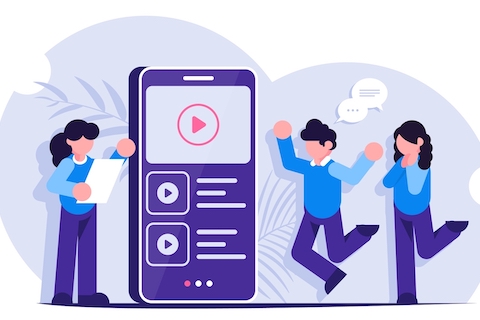Bumper ads are easy to dismiss.
After all, what can you possibly accomplish in just six seconds?
As a result, some advertisers dismiss them out of hand.
But they’re missing the point.
Because bumper ads aren’t designed to be used in isolation.
Combine them with other advertising, such as additional bumper ads or a TrueView video for action ad, and you have a powerful new tool in your arsenal.
In this post, we’ll look closer at bumper ads and examples of how they can be used.
But first, let’s examine the ad format itself.

What Are Bumper Ads?
Bumper ads are short, maximum six-second videos that viewers cannot skip.
While the six-second maximum is often seen as a weakness, it can actually be a strength.
The ads are so short, they’re less likely to annoy viewers. The ad is over before they start looking for a skip option.
You can create bumper ads in Google Ads under the “Video” campaign type.
Bumper ads use target CPM (cost-per-thousand impressions) bidding. (In other words, you pay each time your ad is shown 1,000 times.)
Why Would You Use Bumper Ads?
It’s hard to hold people’s attention with advertising. Many users have become skilled at ignoring ads – even video ads.
This is particularly true when serving ads on a desktop. Users will find something else to hold their attention when a long advertisement plays.
The short length of bumper ads makes them uniquely effective at holding attention. A countdown timer shows viewers how long the ad will last. And the ads are so short there’s no time to turn their attention to something else.
Here’s what Google has to say:
“And while bumpers ads are short on time, they’re long on impact. We tested over 300 bumper campaigns this year and found that 9 out of 10 drove a significant lift in ad recall.”
How to Use Bumper Ads Effectively
One solitary bumper ad isn’t going to do much. You need to think strategically and adhere to the following four principles.
1. Use in Clusters
Bumper ads start to show their worth when they’re used in combination with a group of other bumper ads.
The idea is to build these short ads into a series of ads that tell a larger story, with each ad (perhaps three or five of them) exploring different facets of your message.
2. Mix with Other Ad Formats
Similarly, bumper ads don’t need to be used in isolation as a group.
They can also be combined with other advertising formats. As Google puts it:
“Bumpers can combine to tell a larger story or even be used with other video formats, such as display ads or TrueView, to extend, amplify, or echo what you convey in :06.”
You can also use other types of ad formats as a springboard for your bumper ads. For example, you could start with a print campaign and then use bumper ads to highlight parts of the messaging.
3. Stick to One Thing
With only six seconds to play with, your message has to be sharp and focused. You won’t be able to cover everything you included in your 30-second video ad.
For example, a single bumper ad might:
- Highlight one unique feature.
- Highlight one use for a product line.
- Answer one customer question.
- Feature one common pain point.
- Tease one new product.
4. Make Sure All Ads Are Aligned With Your Overarching Goals
When you’re creating a suite of bumper ads, or bumper ads in combination with other ad formats, it’s important that they’re all aligned in purpose.
With so many pieces in play, it can be easy to have one or more pieces go adrift if you’re not careful.
Example 1: Payroll Software Company
As mentioned, a single bumper ad probably won’t do much. It’s when they’re used in combination that they get powerful.
Here’s an example of how this might work:
Say you’re marketing a payroll software.
You’re competing against larger payroll companies, but your advantages are:
- A simpler user interface.
- Excellent integrations with other tools.
- Competitive pricing.
All of the above advantages can be showcased with bumper ads.
- Bumper ad one could show how easy it is to navigate the user interface.
- Bumper ad two could show the company logos of some of the integrations supported.
- Bumper ad three could show some comparison pricing.
You can drive this strategy even more with 15- or 30-second videos featuring testimonials from happy customers.
And you can finish up the sequence with a TrueView for action campaignthat will drive visitors to your site to create an account.
Not sure about this strategy? Try flipping it on its head. Start with a longer video and then follow up with a series of bumper ads.
An added bonus: Create remarketing ads for those who’ve viewed the videos but haven’t yet taken action.
Example 2: Nonprofit Cancer Research Organization
Let’s look at another example.
Say you’re a nonprofit cancer research organization, and you want to raise awareness of your cause and grow your community.
Again, you can use the same “cluster” method with three or four bumper ads.
Each ad could focus on testimonials from a different cancer survivor that would be inspiring and motivational.
You could conclude the series with a final video with a TrueView for action campaign that takes people back to the website to join your community.
Is It Time to Give Bumper Ads a Try?
Don’t let the short duration of bumper ads put you off.
Again, the idea isn’t to achieve your marketing goals via one six-second ad.
The idea is to build a series of bumper ads, or a series of bumper ads in combination with other ad formats.
Will this type of ad format work for you?
You won’t know until you test it out.
So I encourage you to give it a try.
This article was originally published on Search Engine Journal.






